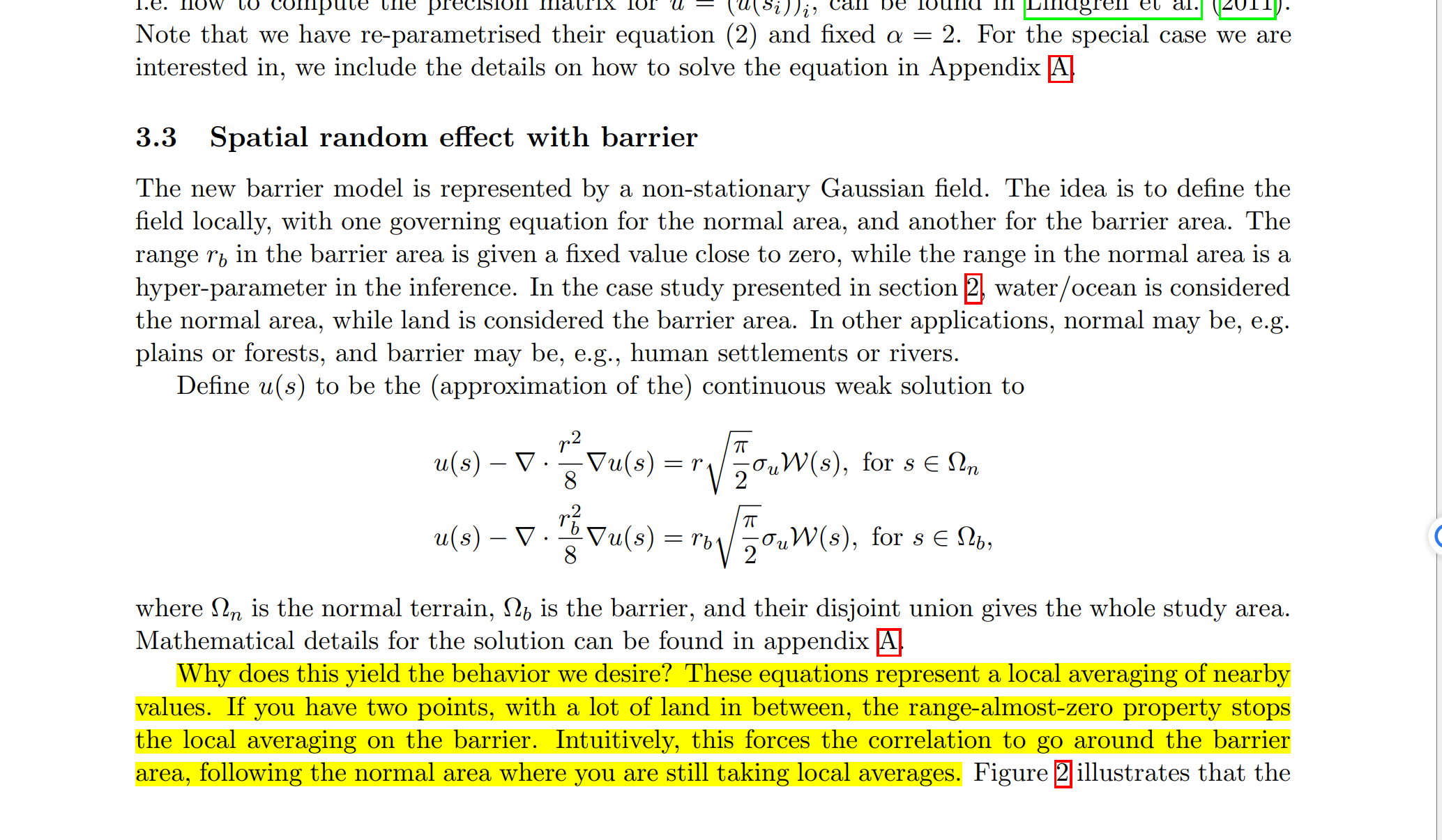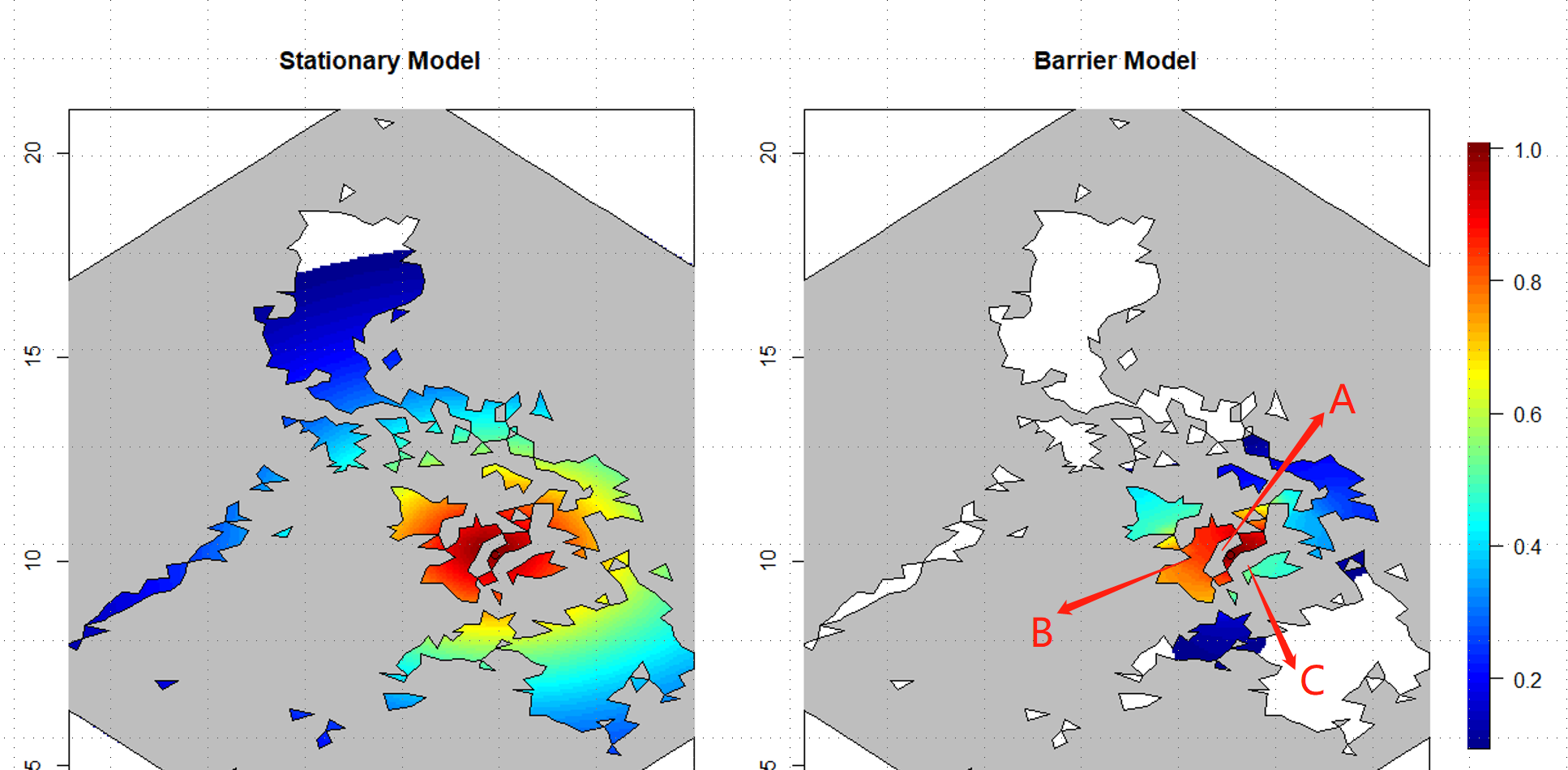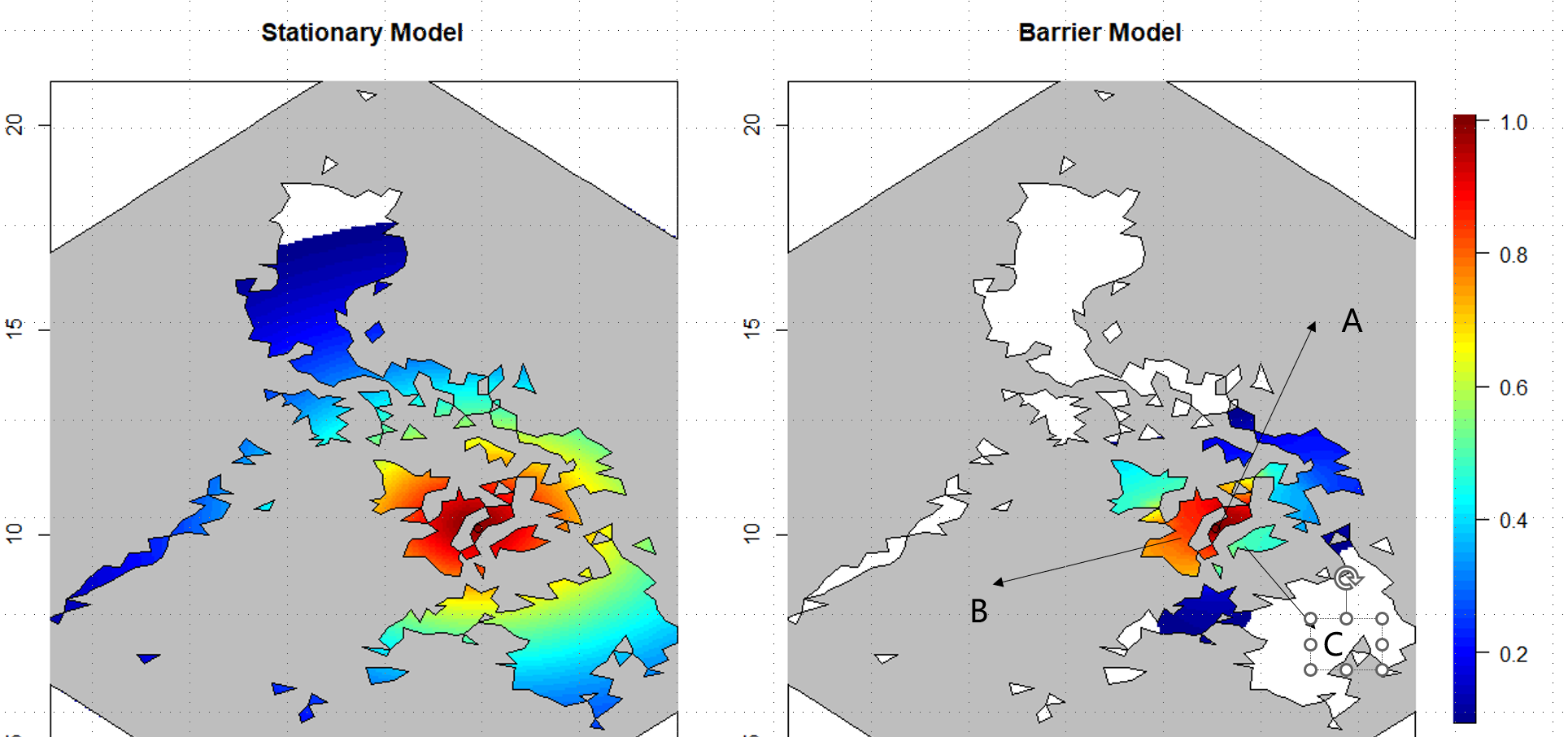Re: [r-inla] spatial modeling with islands
91 views
Skip to first unread message
Message has been deleted
Helpdesk (Haavard Rue)
Nov 5, 2022, 4:42:48 AM11/5/22
to newer, R-inla discussion group
this is the 'barrier' model, see the SPDE book for discussion and how to
use it
On Sat, 2022-11-05 at 00:19 -0700, newer wrote:
> Hello experts!
> When I am modeling the spatial distribution of the disease, I need to
> consider spatially structured random effects and usually introduce the
> matern field as a random effect. However, the field is smooth and
> isotropic. What I would like to ask is whether there is a way to take
> this into account when the study area is an archipelago, where the
> correlation between a point on one island A and another island B is
> weakened by the presence of the ocean?
> Thanks!
> --
> You received this message because you are subscribed to the Google
> Groups "R-inla discussion group" group.
> To unsubscribe from this group and stop receiving emails from it, send
> an email to r-inla-discussion...@googlegroups.com.
> To view this discussion on the web, visit
> https://groups.google.com/d/msgid/r-inla-discussion-group/76ed7459-db7a-492f-9071-1e2eefab1bfbn%40googlegroups.com
> .
--
Håvard Rue
he...@r-inla.org
Message has been deleted
Finn Lindgren
Nov 5, 2022, 6:01:58 AM11/5/22
to newer, R-inla discussion group
It looks like point A and B are connected; the resolution of your map indicates A and B are on the same island. But C is clearly on a different island, which makes the barrier model isolate it from A and B. In your case, the ocean is acting as the barrier.
If A and B are not one the same island and you want them to be disconnected, you would need to increase the map and mesh resolution so that it can see that A and B are really on different islands.
Finn
On 5 Nov 2022, at 09:27, newer <wenlo...@gmail.com> wrote:
Thank you for your reply. I also thought at first that this could be solved by a barrier model. Barrier models are usually used in marine species distribution studies, where islands act as barriers and different r (fields parameter) are set for the ocean and islands, respectively, and two points on either side of the island are connected through the perimeter of the island (i.e., the shortest path). However, the following highlighted words in this literature 《Accounting for Physical Barriers in Species Distribution Modeling With NonStationary Spatial Random Effects》 are not very understandable to me, And it makes me think that barrier models are not suitable for my kind of situation. Because there can't be any physical connection between the two islands.And I have run the code for the barrier model, and the result below is a prior spatial distribution of the correlation, and on the right is the prior for the barrier model. One doubt is that empirically the distance between point A and point B and the distance between point A and point C are basically the same, and also have similar width of the ocean, and the correlation between points B-A and points C-A should be similar, but why the actual result is so different.
To view this discussion on the web, visit https://groups.google.com/d/msgid/r-inla-discussion-group/2eb7c035-0427-4f62-a04f-305707b19e96n%40googlegroups.com.
Message has been deleted
Finn Lindgren
Nov 5, 2022, 7:44:44 AM11/5/22
to newer, R-inla discussion group
That was already how I interpreted the original figure; point A is on an island that in this resolution is touching the island B is on, so the dependence structure connects them. C is clearly separated from them by the ocean, so is not correlated with A.
Finn
On 5 Nov 2022, at 10:48, newer <wenlo...@gmail.com> wrote:
Sorry, I put the wrong figure and my label seems to be misleading, the result should be the following attachment, where the three points A,B,C are my manual rough selection, the initial point of the arrow is the location of the A,B,C, not the location of the letter at the end of the arrow. In addition the gray area is the ocean, the other areas are land, where we set the ocean as an barrier.
To view this discussion on the web, visit https://groups.google.com/d/msgid/r-inla-discussion-group/6bd3e61d-e55d-47f1-a4e9-bd41b8d4449bn%40googlegroups.com.
shicx
Nov 6, 2022, 9:58:49 AM11/6/22
to R-inla discussion group
Hi, inla team
Thanks!
Finn Lindgren
Nov 6, 2022, 1:04:13 PM11/6/22
to shicx, R-inla discussion group
Hi,
this looks like a duplicate of a very similar question from yesterday;
see the Q and answer at
https://groups.google.com/d/msgid/r-inla-discussion-group/76ed7459-db7a-492f-9071-1e2eefab1bfbn%40googlegroups.com
Finn
--
Finn Lindgren
email: finn.l...@gmail.com
this looks like a duplicate of a very similar question from yesterday;
see the Q and answer at
https://groups.google.com/d/msgid/r-inla-discussion-group/76ed7459-db7a-492f-9071-1e2eefab1bfbn%40googlegroups.com
Finn
> --
> You received this message because you are subscribed to the Google Groups "R-inla discussion group" group.
> To unsubscribe from this group and stop receiving emails from it, send an email to r-inla-discussion...@googlegroups.com.
> To view this discussion on the web, visit https://groups.google.com/d/msgid/r-inla-discussion-group/0d9aca36-140d-4956-9b1a-cbc4995dfb26n%40googlegroups.com.
> You received this message because you are subscribed to the Google Groups "R-inla discussion group" group.
> To unsubscribe from this group and stop receiving emails from it, send an email to r-inla-discussion...@googlegroups.com.
--
Finn Lindgren
email: finn.l...@gmail.com
newer
Nov 8, 2022, 6:46:18 AM11/8/22
to R-inla discussion group
thanks for your kind reply.The problem has been solved with your help. But I have to delete this post for data privacy reasons.sorry again.
Reply all
Reply to author
Forward
0 new messages



